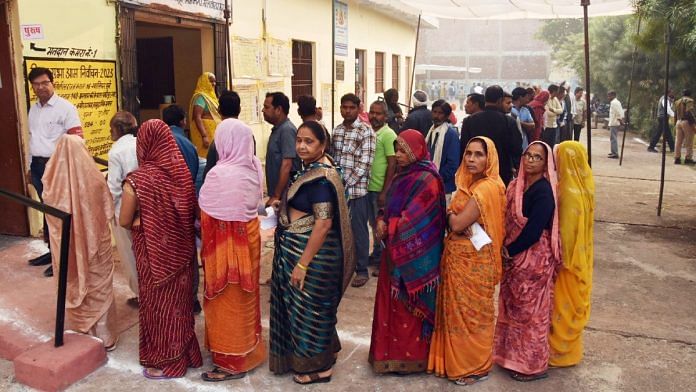Bhopal: That the women’s vote could make or break a campaign in Madhya Pradesh was something both the BJP and the Congress had realised in the run-up to the assembly polls. But an increase of two percentage points in the turnout of women voters has now set the cat among the pigeons, with both key contenders pondering over how this could affect the final outcome.
According to data released by the state election commission Saturday evening, Madhya Pradesh recorded 77.15 percent turnout on 17 November — its highest to date. The data also shows that 78.21 percent of the state’s 2.88 crore registered male voters and 76.03 percent of its 2.72 crore women voters cast their ballots on polling day.
This marked an increase of two percentage points in the voting turnout among women, compared to 2018, when 74.03 percent of the state’s 2.41 crore women voters came out to vote. In absolute numbers, 18.30 lakh more women voted this time than in the previous assembly elections.
The increased turnout among women voters can be ascribed to “natural progression” and is no indication of an advantage to any one party, said Yatindra Singh Sisodia, director and professor at the Madhya Pradesh Institute of Social Science Research in Ujjain.
“If the percentage of women voters had outnumbered male voters or their vote share had touched something like 80 percent, then it was a definite trend of women coming out in large numbers to extend their support to a particular welfare scheme or party, but the increase of two percentage points is natural progression and a result of EC’s efforts to increase participation of women in the democratic process,” Sisodia told ThePrint.
The Election Commission (EC) had last month highlighted the improved electoral gender ratio in Madhya Pradesh, from 917 women for every 1,000 men in 2018 to 945 women for every 1,000 men in 2023. As many as 31 lakh new women voters were added to the electoral roll in Madhya Pradesh this time, taking the total tally of women voters in the state to 2.72 crore, or 48 percent of the state’s 5.6 crore voters.
Also Read: How Congress & BJP are competing to woo youth in poll-bound MP — ‘IPL team’ to skill development
‘BJP failed to own Ladli Behna Yojana’
Both the BJP and the Congress had laid great emphasis on women voters in their poll pitch. The BJP relied on ‘Ladli Behna Yojana’, announced 33 percent quota for women in police recruitment and up to 50 percent in teaching jobs.
The Congress, on the other hand, promised Rs 1,500 as monthly financial assistance to women in the state, if voted to power. On its part, the Congress also accused the Shivraj Singh Chouhan-led BJP government of failing to curb crimes against women.
Not long after polling concluded Friday, state BJP president V.D. Sharma claimed that women voters had come out in large numbers in support of the party.
According to him, this was the result of the BJP’s commitment in the form of pucca houses under the Pradhan Mantri Awas Yojana, LPG connections under the Ujjwala Yojana and monthly financial aid and other benefits under the Ladli Behna Yojana.
Prime Minister Narendra Modi’s ‘Beti Bachao, Beti Padhao’ (save, educate the girl child) initiative also played a crucial role in the assembly polls this time, Sharma told media persons in Bhopal. He added, “Women have participated in large numbers, while women from minority communities have also supported the BJP over its stance on Triple Talaq.”
Though women voters outnumber their male counterparts in 29 of the state’s 230 assembly seats, their turnout exceeded that of male voters in 34 seats this time, according to an analysis by The Print of state election commission data. The analysis also revealed that of these 34 seats, BJP MLAs were incumbents in 25 and Congress MLAs in the remaining nine.
In comparison, while women voters outnumbered men in 10 assembly seats, their turnout was higher than that of their male counterparts in 51 seats in 2018.
With the BJP crediting its women-centric schemes for higher turnout of women voters, Congress leaders stressed that the percentage of women who cast their ballots was still lower than that of male voters.
“The final figures of the assembly election show that, like every time, even this time women have not only voted less than their male counterparts, but their participation has been lesser than that of 2018. In 2018, turnout of women voters was 1.95 percent less than male turnout while in 2023, their voting percentage is 2.18 percent less than that of the men,” Piyush Babele, media advisor to state Congress chief Kamal Nath, told ThePrint.
To add to that, according to political analyst Rasheed Kidwai, the BJP failed to deliver benefits of Ladli Behna Yojana to each household in Madhya Pradesh.
“It was an initiative of the MP government headed by Shivraj Singh Chouhan but the party failed in owning it. Besides, a lot of these seats with a higher women percentage are concentrated in Vindhya and Mahakaushal region where there is rampant migration with women back at home as men are away working,” said Kidwai.
He also said that though BJP’s campaign was dominated by its central leadership and concentrated around the Ram temple in Ayodhya, it did not give the BJP any tactical advantage since there was no opposition to the idea by the Congress.
“The BJP, despite several rallies of the Prime Minister, did not see the party owning the Ladli Behna initiative and it was only during the last leg of the campaign that they began mentioning it. The BJP failed to have a sharp clinical approach to its campaign which largely remained a knee-jerk reaction to the emerging situation,” Kidwai added.
(Edited by Amrtansh Arora)
Also Read: ‘Pehle ghode pe baithte the, ab gadhe par’ — anger with BJP, caste loyalty reign supreme in Dimani



